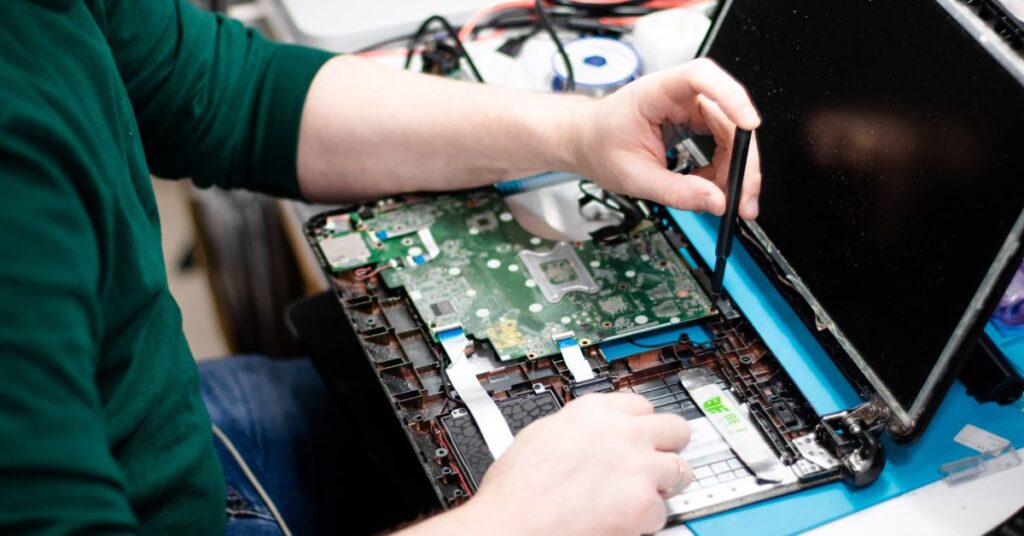Have you ever wondered where the motherboard is located in a laptop? It’s the essential part that keeps all the crucial hardware together and makes your laptop work. We will talk about the motherboard’s precise location in a laptop in this article, as well as why it is such an important component.
Table of Contents
Understanding the Motherboard
Definition and Function: The motherboard is a large circuit board that houses various essential components, including the CPU (Central Processing Unit), GPU (Graphics Processing Unit), RAM (Random Access Memory) slots, storage interfaces, and peripheral connectors. Its primary function is to provide a platform for these components to communicate and interact with each other.
Components Housed: The motherboard houses several essential parts that are necessary for your laptop to function. The CPU, which is directly mounted on the motherboard and is frequently referred to as the “brain” of the computer, is responsible for processing commands and carrying out tasks. The motherboard and the GPU, which render graphics and visuals, are integrated or connected. RAM modules, which offer temporary storage for running programs and data, can also be installed in slots on the motherboard.
Other Features: The motherboard has several ports and connectors in addition to its essential parts that let you connect with external devices. These could be expansion card slots (such as PCIe slots for adding extra functionality like dedicated graphics cards or network adapters), Ethernet ports, audio jacks, USB ports, HDMI ports, and audio ports.
Further reading: Why motherboard fail in laptop?
Where is the Motherboard Located in a Laptop?

Internally, the motherboard is strategically positioned at the heart of your laptop, serving as the central foundation upon which all other components are connected. However, accessing the motherboard requires a bit of disassembly, as it’s nestled beneath several layers of components and the laptop’s casing.
To access the motherboard, you’ll often need to remove the bottom cover of your laptop, which is usually secured by screws. Once the cover is off, you’ll gain access to the internal components, including the motherboard.
Within the laptop’s chassis, the motherboard is typically located near the center, underneath the keyboard and touchpad. This central placement allows for efficient distribution of components and facilitates optimal connectivity between the various hardware elements.
The motherboard’s location within the laptop plays a crucial role in determining factors such as the device’s overall size, weight distribution, and internal layout. Manufacturers carefully design the internal structure to ensure that the motherboard fits snugly within the chassis while maximizing space for other components.
Also, user accessibility and repairability are impacted by the motherboard’s location. Simple operations like replacing malfunctioning parts or upgrading RAM are made easier by the motherboard’s easy accessibility, but more difficult disassembly techniques might be needed if it were located somewhere more covert.
Further reading: Who found the motherboard?
How does the Motherboard Fit into the Laptop Chassis?
The motherboard is a pivotal component in the intricate design of a laptop, and its fitting into the chassis involves careful planning and engineering.
- Size and Shape Considerations: Laptop manufacturers meticulously design the motherboard to fit the specific dimensions and shape of the chassis. This ensures a snug fit without wasted space, contributing to the laptop’s compact form factor.
- Mounting Points: The motherboard is secured to the laptop chassis using mounting points or standoffs. These are small raised areas on the chassis that align with corresponding screw holes on the motherboard. By securely fastening the motherboard to these points, stability is ensured, minimizing the risk of damage due to movement or vibration.
- Integration with Other Components: The motherboard is designed to accommodate various other components, such as the CPU, GPU, RAM slots, and storage connectors. These components are positioned strategically on the motherboard to optimize space utilization and facilitate efficient communication between them.
- Connector Placement: Connectors and ports on the motherboard, such as USB ports, HDMI ports, and audio jacks, are positioned along the edges or sides of the motherboard. This placement allows for easy access when connecting external devices while maintaining a tidy internal layout.
- Cooling Considerations: The motherboard layout also takes into account the cooling system of the laptop. Heat-generating components like the CPU and GPU are positioned in areas where airflow from the cooling fans can effectively dissipate heat. Additionally, heat sinks and thermal pads may be used to transfer heat away from critical components to ensure optimal performance and longevity.
- Cable Management: Internal cables for power distribution, data transfer, and other functions are routed strategically around the motherboard to minimize clutter and optimize airflow. Proper cable management not only ensures reliable connectivity but also contributes to overall system reliability and performance.
- Accessibility for Maintenance and Upgrades: While securely integrated into the chassis, the motherboard’s layout also considers accessibility for maintenance and upgrades. Components such as RAM modules and storage drives are typically located in easily accessible areas, simplifying the process of upgrading or replacing them.
Further reading: Why Are Motherboards So Expensive?
Importance of the Motherboard’s Location
The motherboard’s location within your laptop isn’t just a matter of convenience; it significantly impacts the device’s design, functionality, and user experience.

Here’s why the motherboard’s placement is crucial:
- Internal Layout Efficiency: The motherboard’s position within the laptop chassis directly influences the internal layout of components. Manufacturers strategically place the motherboard to optimize space utilization and ensure efficient routing of connections between various hardware elements. A well-designed layout minimizes clutter, enhances airflow for cooling, and contributes to overall system stability and performance.
- Compactness and Portability: For laptops, size and weight are critical considerations. The location of the motherboard within the chassis affects the overall dimensions and weight distribution of the device. By positioning the motherboard centrally or in a specific area, manufacturers can achieve a more balanced weight distribution and create slimmer, more portable designs without sacrificing performance or functionality.
- Accessibility for Upgrades and Repairs: Easy access to the motherboard simplifies maintenance tasks such as upgrading RAM, replacing the CPU, or troubleshooting hardware issues. A well-placed motherboard with accessible components allows users or technicians to perform upgrades or repairs efficiently, reducing downtime and service costs. Conversely, if the motherboard is buried deep within the laptop’s internals, accessing it may require more extensive disassembly, making repairs or upgrades more challenging and time-consuming.
- Thermal Management: The location of the motherboard influences thermal management within the laptop. Components such as the CPU and GPU generate heat during operation, and effective cooling is essential to prevent overheating and ensure optimal performance. By positioning the motherboard strategically, manufacturers can design efficient cooling solutions, such as heat pipes, fans, and heat sinks, to dissipate heat effectively and maintain optimal operating temperatures for critical components.
- Structural Integrity: The motherboard serves as a structural component that reinforces the laptop’s internal framework. Its location and secure mounting within the chassis contribute to the device’s overall structural integrity and durability, protecting internal components from physical damage or shock during handling or transportation.
Conclusion
The motherboard is a critical component within your laptop, serving as the central hub for all hardware connections and facilitating smooth operation. Its location within the chassis impacts the device’s design, functionality, accessibility, and user experience.
Gaining knowledge about the location and importance of the motherboard can help you better understand the internal architecture of your laptop. Having this knowledge will enable you to appreciate the meticulous design that goes into making modern laptops, complete maintenance tasks more quickly, and upgrade components with knowledge.
In the end, the motherboard’s pivotal function emphasizes how crucial it is in determining your laptop’s functionality and performance. Therefore, keep in mind the crucial role the motherboard plays at the heart of your device the next time you use it.
FAQ
How can I access the motherboard on my laptop?
Accessing the motherboard usually involves removing the bottom cover of the laptop, which is often secured by screws. Once the cover is off, you’ll have access to the internal components, including the motherboard.
Can I upgrade the components on the motherboard?
Yes, certain components such as RAM and storage drives are often upgradeable. However, the upgradability of other components like the CPU and GPU may vary depending on the laptop’s design and specifications. Always consult your laptop’s manual or manufacturer’s guidelines before attempting any upgrades.
Is it possible to replace a faulty motherboard in a laptop?
While it’s technically possible to replace a faulty motherboard in a laptop, it’s often a complex and labor-intensive process that may require professional assistance. Additionally, the cost of replacing a motherboard in a laptop can be significant, so it’s essential to weigh the pros and cons before proceeding.
Can I damage the motherboard when accessing it for maintenance?
While it’s unlikely to damage the motherboard if you follow proper procedures and handle components carefully, there’s always a risk of accidental damage, especially if you’re unfamiliar with laptop internals. If you’re unsure, it’s best to seek assistance from a qualified technician.
